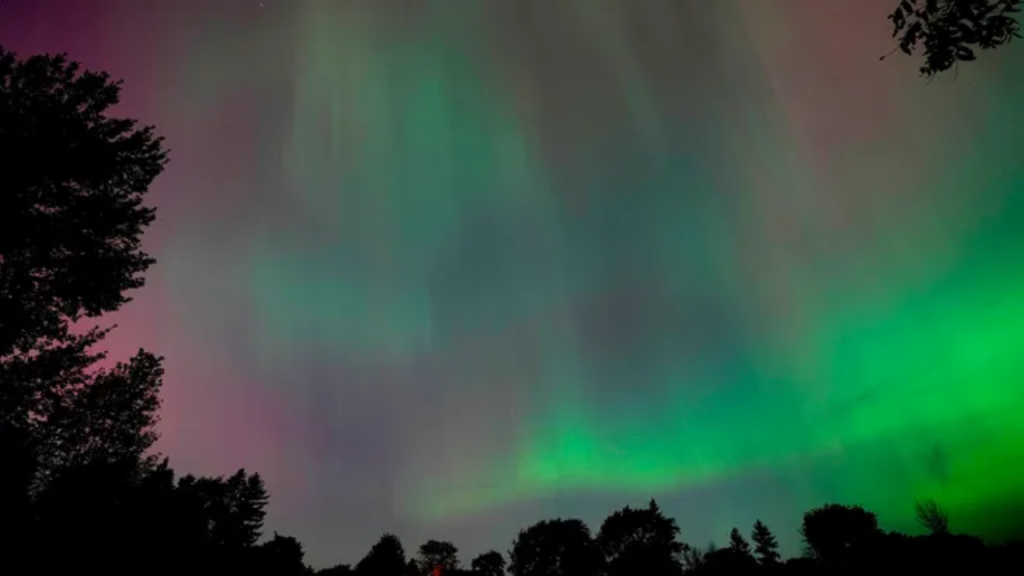A rare celestial event could light up the skies across central and northern Wisconsin tonight, as a powerful geomagnetic storm triggers a wide-reaching aurora borealis display.
The National Oceanic and Atmospheric Administration (NOAA) has issued a G4 (Severe) geomagnetic storm alert, meaning that the northern lights, typically only visible in Canada or the Arctic, may extend much farther south than usual. Residents in parts of Wisconsin may get a rare glimpse of the aurora late Sunday night into early Monday morning.
The event is being driven by a coronal mass ejection (CME) from the sun—a massive burst of solar wind and magnetic fields that reached Earth’s atmosphere over the weekend.
“A strong geomagnetic storm watch remains in effect through tonight,” NOAA officials said. “Conditions are favorable for auroral activity as far south as Illinois, Ohio, and even parts of the central Plains.”
Best Times to Watch in Wisconsin
For those hoping to catch the aurora, the best viewing times are between 10 p.m. and 2 a.m. local time, when the sky is at its darkest. Cloud cover is expected to be minimal in many regions across the state, offering clear skies for skywatchers.
Areas with less light pollution, such as rural or suburban settings, will offer the best visibility. Towns like Wausau, Green Bay, Eau Claire, and parts of Door County are considered favorable locations.

How to View and Photograph the Aurora
Experts recommend getting as far away from city lights as possible and facing north for optimal visibility. To capture the aurora on camera, use a tripod and long-exposure settings with manual adjustments for ISO and aperture.
Auroras typically appear as glowing green ribbons of light but can also include reds, purples, and blues depending on altitude and atmospheric conditions.
Weather Outlook Across Key Wisconsin Cities:
- Wausau: Clear skies, temperatures around 54°F (12°C)
- Green Bay: Clear skies, approximately 56°F (14°C)
- Eau Claire: Clear skies, slightly warmer at 61°F (16°C)
However, there is a slight caveat. Wisconsin may experience lingering haze due to Canadian wildfire smoke, which could obscure visibility in some areas, especially near the horizon.
What Causes the Aurora Borealis?
The aurora borealis, or northern lights, occur when charged particles from the sun collide with gases in Earth’s atmosphere. These particles are directed toward the poles by Earth’s magnetic field. When they hit oxygen and nitrogen molecules, they emit light – the glowing ribbons seen in the night sky.
G4-level geomagnetic storms are relatively rare and indicate significant solar activity. Such storms can also cause minor disruptions to GPS systems, satellite communications, and even power grids, though no major issues have been reported so far.
Why This Event Is Special for Wisconsin
Events like this allow residents a unique chance to witness one of nature’s most stunning phenomena from their own backyards.
So far, there have already been confirmed aurora sightings across Montana, North Dakota, and Michigan’s Upper Peninsula. If conditions remain steady, Wisconsin is in for a rare treat tonight.
If you do spot the aurora, experts recommend staying calm and letting your eyes adjust to the dark. Some of the best displays may only last for a few minutes before fading. Be patient—and dress warm.
Residents are also encouraged to share photos and experiences using local news station hashtags or tag the NOAA on social media to contribute to citizen science efforts.
Stay tuned for updates from your local meteorological station or the National Weather Service to get the latest alerts as the night progresses.


